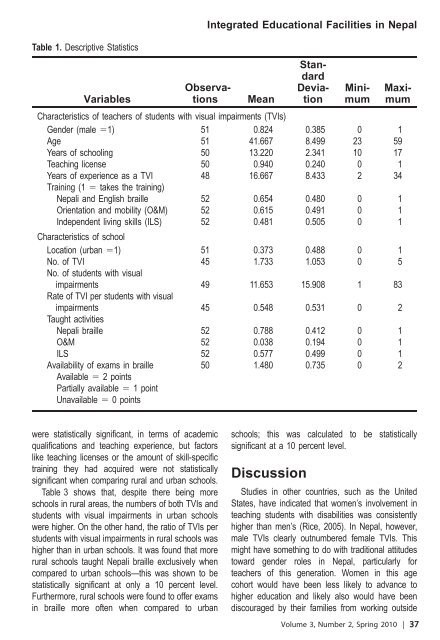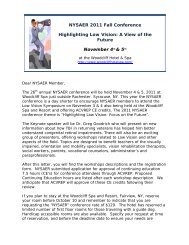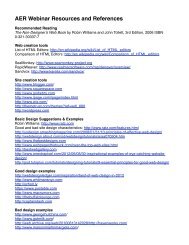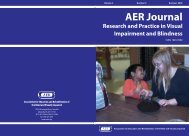Association for Education and Rehabilitation of the Blind - AER Online
Association for Education and Rehabilitation of the Blind - AER Online
Association for Education and Rehabilitation of the Blind - AER Online
You also want an ePaper? Increase the reach of your titles
YUMPU automatically turns print PDFs into web optimized ePapers that Google loves.
Table 1. Descriptive Statistics<br />
Variables<br />
were statistically significant, in terms <strong>of</strong> academic<br />
qualifications <strong>and</strong> teaching experience, but factors<br />
like teaching licenses or <strong>the</strong> amount <strong>of</strong> skill-specific<br />
training <strong>the</strong>y had acquired were not statistically<br />
significant when comparing rural <strong>and</strong> urban schools.<br />
Table 3 shows that, despite <strong>the</strong>re being more<br />
schools in rural areas, <strong>the</strong> numbers <strong>of</strong> both TVIs <strong>and</strong><br />
students with visual impairments in urban schools<br />
were higher. On <strong>the</strong> o<strong>the</strong>r h<strong>and</strong>, <strong>the</strong> ratio <strong>of</strong> TVIs per<br />
students with visual impairments in rural schools was<br />
higher than in urban schools. It was found that more<br />
rural schools taught Nepali braille exclusively when<br />
compared to urban schools—this was shown to be<br />
statistically significant at only a 10 percent level.<br />
Fur<strong>the</strong>rmore, rural schools were found to <strong>of</strong>fer exams<br />
in braille more <strong>of</strong>ten when compared to urban<br />
Integrated <strong>Education</strong>al Facilities in Nepal<br />
Observations<br />
Mean<br />
schools; this was calculated to be statistically<br />
significant at a 10 percent level.<br />
Discussion<br />
St<strong>and</strong>ardDeviation<br />
Minimum<br />
Maximum<br />
Characteristics <strong>of</strong> teachers <strong>of</strong> students with visual impairments (TVIs)<br />
Gender (male 51) 51 0.824 0.385 0 1<br />
Age 51 41.667 8.499 23 59<br />
Years <strong>of</strong> schooling 50 13.220 2.341 10 17<br />
Teaching license 50 0.940 0.240 0 1<br />
Years <strong>of</strong> experience as a TVI<br />
Training (1 5 takes <strong>the</strong> training)<br />
48 16.667 8.433 2 34<br />
Nepali <strong>and</strong> English braille 52 0.654 0.480 0 1<br />
Orientation <strong>and</strong> mobility (O&M) 52 0.615 0.491 0 1<br />
Independent living skills (ILS)<br />
Characteristics <strong>of</strong> school<br />
52 0.481 0.505 0 1<br />
Location (urban 51) 51 0.373 0.488 0 1<br />
No. <strong>of</strong> TVI<br />
No. <strong>of</strong> students with visual<br />
45 1.733 1.053 0 5<br />
impairments<br />
Rate <strong>of</strong> TVI per students with visual<br />
49 11.653 15.908 1 83<br />
impairments<br />
Taught activities<br />
45 0.548 0.531 0 2<br />
Nepali braille 52 0.788 0.412 0 1<br />
O&M 52 0.038 0.194 0 1<br />
ILS 52 0.577 0.499 0 1<br />
Availability <strong>of</strong> exams in braille<br />
Available 5 2 points<br />
Partially available 5 1 point<br />
Unavailable 5 0 points<br />
50 1.480 0.735 0 2<br />
Studies in o<strong>the</strong>r countries, such as <strong>the</strong> United<br />
States, have indicated that women’s involvement in<br />
teaching students with disabilities was consistently<br />
higher than men’s (Rice, 2005). In Nepal, however,<br />
male TVIs clearly outnumbered female TVIs. This<br />
might have something to do with traditional attitudes<br />
toward gender roles in Nepal, particularly <strong>for</strong><br />
teachers <strong>of</strong> this generation. Women in this age<br />
cohort would have been less likely to advance to<br />
higher education <strong>and</strong> likely also would have been<br />
discouraged by <strong>the</strong>ir families from working outside<br />
Volume 3, Number 2, Spring 2010 | 37







